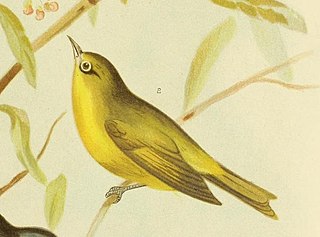
Zosterops is a genus of passerine birds containing the typical white-eyes in the white-eye family Zosteropidae. The genus has the largest number of species in the white-eye family. They occur in the Afrotropical, Indomalayan, and Australasian realms. Typical white-eyes have a length of between 8 and 15 cm. Their most characteristic feature is a conspicuous white feather ring around the eye, though some species lack it. The species in this group vary in the structural adaptations of the tongue. The Zosterops [griseotinctus] group is an example of a "great speciator" inhabiting a vast area and showing a remarkable morphological differentiation on islands, some of which may be as close as 2 km (1.2 mi) apart.
Sanford's white-eye is a species of bird in the family Zosteropidae. It is endemic to Nendo Island.

The ashy-bellied white-eye is a species of bird in the family Zosteropidae found in the Lesser Sunda Islands in the Indonesian Archipelago and northern Cape York Peninsula in Queensland, Australia. It is sometimes called the pale white-eye or pale-bellied white-eye, but should not be confused with the pale-bellied white-eye.

The bridled white-eye is a species of white-eye native to the Mariana Islands and formerly Guam. The species' natural habitat is tropical forests, shrublands and urban areas.

Everett's white-eye is a bird species in the disputed family Zosteropidae, which might belong with the Old World babblers (Timaliidae). The name commemorates British colonial administrator and zoological collector Alfred Hart Everett. It is only found on the Talaud Islands, Sulu Archipelago and the Philippines. Its natural habitats are tropical moist lowland forests and tropical moist montane forests.

The Fiji white-eye is a species of passerine bird in the white-eye family Zosteropidae. The species is also known as Layard's white-eye.

The Solomons white-eye or New Georgia white-eye is a species of bird in the family Zosteropidae. It is endemic to the New Georgia Islands in the Solomon Islands. It is also known as Zosterops rendovae but this name properly refers to the grey-throated white-eye.
The Gizo white-eye or yellow-billed white-eye is a species of bird in the family Zosteropidae.

The canary white-eye or yellow white-eye is a species of white-eye endemic to northern Australia in subtropical or tropical mangrove forests. Its common name reflects the circle of white feathers around its eye.

The Mayotte white-eye or chestnut-sided white-eye is a species of bird in the family Zosteropidae. It is now found only on Mayotte in the Comoro Islands. Its natural habitats are subtropical or tropical dry forests, subtropical or tropical moist lowland forests, and subtropical or tropical mangrove forests.

The lowland white-eye is a species of bird in the family Zosteropidae. It is near endemic to the northern part of the Philippines but is also found on the Taiwanese islands of Lüdao and Lanyu. Its natural habitat is tropical moist lowland forest, second growth and gardens.
The Karthala white-eye, also known as the Mount Karthala white-eye, Grand Comore white-eye, or Comoro white-eye, is a species of bird in the family Zosteropidae. As suggested by its name, it is endemic to Philippia heath woodland growing on Mount Karthala on the island of Grand Comore in the Comoros. Mount Karthala is an active volcano and future eruptions pose a serious threat to the Karthala white-eye. The bird is further threatened by human-induced habitat loss.

The yellowish white-eye or golden-yellow white-eye, is a species of bird in the family Zosteropidae. It is endemic to the Philippines. Its natural habitat is tropical moist lowland forests.

The olive-colored white-eye, also known as the olive white-eye, Yap olive white-eye or great Yap white-eye, is a species of bird in the family Zosteropidae. The indigenous name in the Yapese language is "Alingithngith", which applies to both species of Zosterops found in Yap.

The Makira white-eye, also known as the grey-throated white-eye, is a small passerine bird in the white-eye family, Zosteropidae. It is also known as Zosterops ugiensis because Z. rendovae has often been used for the Solomons white-eye.
The Rennell white-eye or the bare-ringed white-eye, is a species of bird in the family Zosteropidae. It is endemic to Rennell Island in the Solomon Islands. Its natural habitat is subtropical or tropical moist lowland forests.
The Ranongga white-eye or splendid white-eye is a species of bird in the family Zosteropidae. It is endemic to the Solomon Islands.

The robust white-eye, also known as the Lord Howe white-eye or robust silvereye and locally as the "big grinnell", is an extinct species of bird in the family Zosteropidae. It was endemic to the lowland forests of Lord Howe Island, east of Australia.
The pale white-eye also known as Kenya white-eye is a bird species in the family Zosteropidae. It is found in Kenya, eastern Tanzania, southern Ethiopia and southern Somalia.
The black-fronted white-eye is a songbird species. It is closely related to the Old World babblers, and its family Zosteropidae might better be included in the Tiimalidae. The black-fronted white-eye was formerly considered a subspecies of the green-fronted white-eye,, and until it was split as a distinct species, the name "black-fronted white-eye" was also used for Z. minor.













